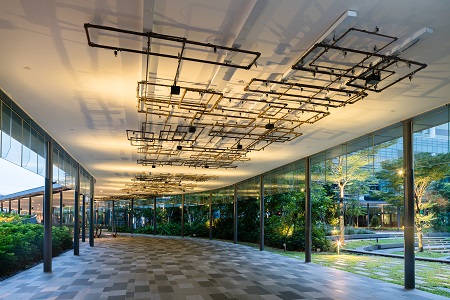Zul Mahmod is noted as one of Singapore’s leading sound artist. As a sound artist, Zul has been interested in sound-media with a mix of interdisciplinary and experimental approaches. He is known for integrating 3D forms such as his copper pipe installations that are massive and are visually arresting when looked at.
The work that I am examining is a work that is particularly different from the rest of Zul’s repertoire. While many of his soundscapes are made pre-recorded or programmed to sound the same, Dialog is a work that is influenced by the people that are present in the vicinity. The work changes with the audience, with every audience transmitting sound that moves through the Esplanade tunnel. It is essentially like a live version of the telephone game where the sound begins to be displaced post-transmission. As such, Dialog is a work that showcases interactive media due to its interactive nature because the work requires audience response and the results are not predetermined by the artist
When discussing the work of Nam June Paik to illustrate the ideas of interactivity, his work Magnet TV requires the viewer to move the magnet around the TV. Nam June Paik’s body of work, although backs his claim as the “father of video art” with his work – Magnet TV, the breakthrough of it is also due to the incorporation of requiring audience participation. Similarly, Dialog displaces the audiences’ senses by providing and aural and visual intervention at the Esplanade Tunnel. Using the echoey environment of the tunnel, Zul programmes the work to take in sound made by the surroundings to create sound through solenoids and copper pipes. At a default setting, the sound created by the echo already interacts with the artwork. With the added sound by viewers – through their involuntary steps (across the tunnel), or voluntary sounds, the sound changes, disrupting the default state of the work. Conclusively, Dialog by Zul Mahmod fulfils this criterion in which it is a form of interactive art due to its requirement of audience interaction.
Apart from the requirement for audience interaction, another important point to determine if an artwork is a form of interactive media is that it should be unpredictable. As a form of cybernetics, Zul programmed the work to create sound on its own while interacting with the surroundings. It is similar to how Wiener (1954) describes Cybernetics as a term “…the study of messages as a means of controlling machinery and society, the development of computing machines and other such automata, certain reflections upon psychology and the nervous system”. However, apart from it being self-regulatory, Dialog is also a form of Behaviorist Art. As Ascott (1966) defines behaviorist art as “a retroactive process of human involvement, in which the artefact[sic] functions as both matrix and catalyst.” Dialog provides feedback to the human involvement it receives. It develops the sound as a matrix but is also a catalyst as its site specific nature orders the viewer to walk through the work, creating involuntary walking sounds that react with the work itself. It also reacts with itself.
To build up on the previous point. While Dialog is in its default state, predetermined, the experience evoked per audience provides an independent output. This creates a experience which Ascott (1966) derives as “more variety into the system and leads to more variety in the output.”
If we compared to work to the sound art of John Cage, it is essentially very similar. While John Cage decided on the types of sounds, textures for Variations V, and essentially the work was an interaction of sound and movement with programmed staged lightings to trigger the dancers to move to create the sound, Zul had programmed the solenoids, microcontrollers and copper pipes to produce sound. The reactivity is also similar to Robert Rashchenberg’s Soundings which produces light from pitch of voice. In essence, the similarity in nature of the artworks highlights the discipline of which Zul Mahmod’s Dialog is indeed, an interactive work since it is reactive to an individuals experience and the input given to the work by the audience produces variable output.
Conclusively, we can determine the Zul Mahmod’s Dialog is a form of Interactive Media through the use of interactivity. By producing sound and being on the genre of sound art, Zul expands his repertoire by adding an interactive element to his work.
Following Dialog in 2016, Zul had also made another interactive work, SONICconversation. Similar to Dialog, the work interacts with the acoustics of the environment, allowing the audience to play a part in the work. In nature, Zul’s work at the default state already produces sound that becomes echoed for the work itself to generate a response. While arguable that Dialog is not an interactive work as it is already predetermined by its default state, it however is still interactive as the different audience interaction then becomes another layer of sound for the cybernetic work to react to. Due to the fact that Dialog requires and audience feedback and that the work itself is not predetermined, thus it is a form of interactive media.
References :
- Smith, R. (2006, January 31). Nam June Paik, 73, Dies; Pioneer of Video Art Whose Work Broke Cultural Barriers. Retrieved from https://www.nytimes.com/2006/01/31/arts/design/nam-june-paik-73-dies-pioneer-of-video-art-whose-work-broke.html
- Media Art Net. (n.d.). Media Art Net | Cage, John: Variations V. Retrieved from http://www.medienkunstnetz.de/works/variations-v/
- Norbert Wiener, “Cybernetics in History,” 1954, Multimedia: From Wagner to Virtual Reality
- Roy Ascott, “Behavioral Art and the Cybernetic Vision,” 1966, Multimedia: From Wagner to Virtual Reality



